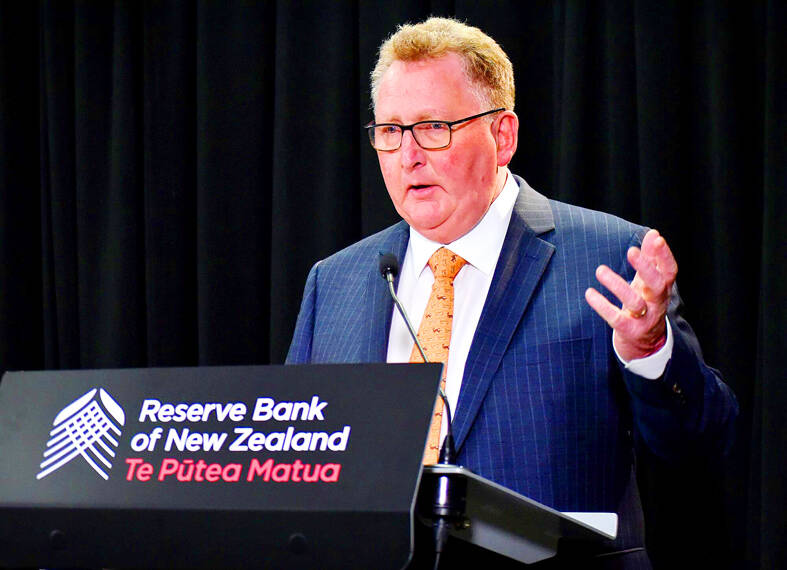Reserve Bank of New Zealand Governor Adrian Orr has issued a warning about crytocurrencies such as stablecoins, saying they are no substitute for fiat money.
Stablecoins are “the biggest misnomers” and “oxymorons,” Orr told a parliamentary committee yesterday in Wellington. “Stablecoins are not stable. They’re only as good as the balance sheet of the person offering that stablecoin.”
Stablecoins, a form of crypto token pegged to another asset, use large reserves to support their value. They can be buffeted by troubles in the traditional financial world, and some worry they could have the potential to rock real-world markets in return.

Photo: Bloomberg
Orr was asked whether central banks are concerned that independent digital currencies could undermine the global financial system.
“The answer is yes, critically concerned,” he said. “Mostly in that what is advertised on the tin is not what is in the tin for these purported alternatives to central bank cash.”
Orr said bitcoin is not a means of exchange, a store of value or a unit of account “yet people try to use it as that.”
“It’s got other purposes but it is not at all a substitute for, not even a complement to, central bank money,” he said.
Fiat currencies such as the New Zealand dollar exist because they have the power of parliament behind them “and a credible institution such as an independent central bank to maintain low and stable inflation,” he added.

PATENTS: MediaTek Inc said it would not comment on ongoing legal cases, but does not expect the legal action by Huawei to affect its business operations Smartphone integrated chips designer MediaTek Inc (聯發科) on Friday said that a lawsuit filed by Chinese smartphone brand Huawei Technologies Co (華為) over alleged patent infringements would have little impact on its operations. In an announcement posted on the Taiwan Stock Exchange, MediaTek said that it would not comment on an ongoing legal case. However, the company said that Huawei’s legal action would have little impact on its operations. MediaTek’s statement came after China-based PRIP Research said on Thursday that Huawei filed a lawsuit with a Chinese district court claiming that MediaTek infringed on its patents. The infringement mentioned in the lawsuit likely involved

Taipei is today suspending work, classes and its US$2.4 trillion stock market as Typhoon Gaemi approaches Taiwan with strong winds and heavy rain. The nation is not conducting securities, currency or fixed income trading, statements from its stock and currency exchanges said. Authorities had yesterday issued a warning that the storm could affect people on land and canceled some ship crossings and domestic flights. Taiwan Semiconductor Manufacturing Co (TSMC, 台積電) expects its local chipmaking fabs to maintain normal production, the company said in an e-mailed statement. The main chipmaker for Apple Inc and Nvidia Corp said it has activated routine typhoon alert

GROWTH: TSMC increased its projected revenue growth for this year to more than 25 percent, citing stronger-than-expected demand for AI devices and smartphones The Taiwan Institute of Economic Research (TIER, 台灣經濟研究院) yesterday raised its forecast for Taiwan’s GDP growth this year from 3.29 percent to 3.85 percent, as exports and private investment recovered faster than it predicted three months ago. The Taipei-based think tank also expects that Taiwan would see a 8.19 percent increase in exports this year, better than the 7.55 percent it projected in April, as US technology giants spent more money on artificial intelligence (AI) infrastructure and development. “There will be more AI servers going forward, but it remains to be seen if the momentum would extend to personal computers, smartphones and

Catastrophic computer outages caused by a software update from one company have once again exposed the dangers of global technological dependence on a handful of players, experts said on Friday. A flawed update sent out by the little-known security firm CrowdStrike Holdings Inc brought airlines, TV stations and myriad other aspects of daily life to a standstill. The outages affected companies or individuals that use CrowdStrike on the Microsoft Inc’s Windows platform. When they applied the update, the incompatible software crashed computers into a frozen state known as the “blue screen of death.” “Today CrowdStrike has become a household name, but not in